Sensitivity Analysis of Modal Parameters of a Jacket Offshore Wind Turbine to Operational Conditions
Abstract
:1. Introduction
2. Materials and Methods
2.1. B2 OWT at the BIWF
2.1.1. B2 OWT Structural Information
2.1.2. Instrumentation of Monitoring System and Identified Modal Parameters
2.1.3. System Identification Results
2.2. Modeling of B2 OWT
2.2.1. OpenSees and SAP2000 Models
2.2.2. OpenFAST Model
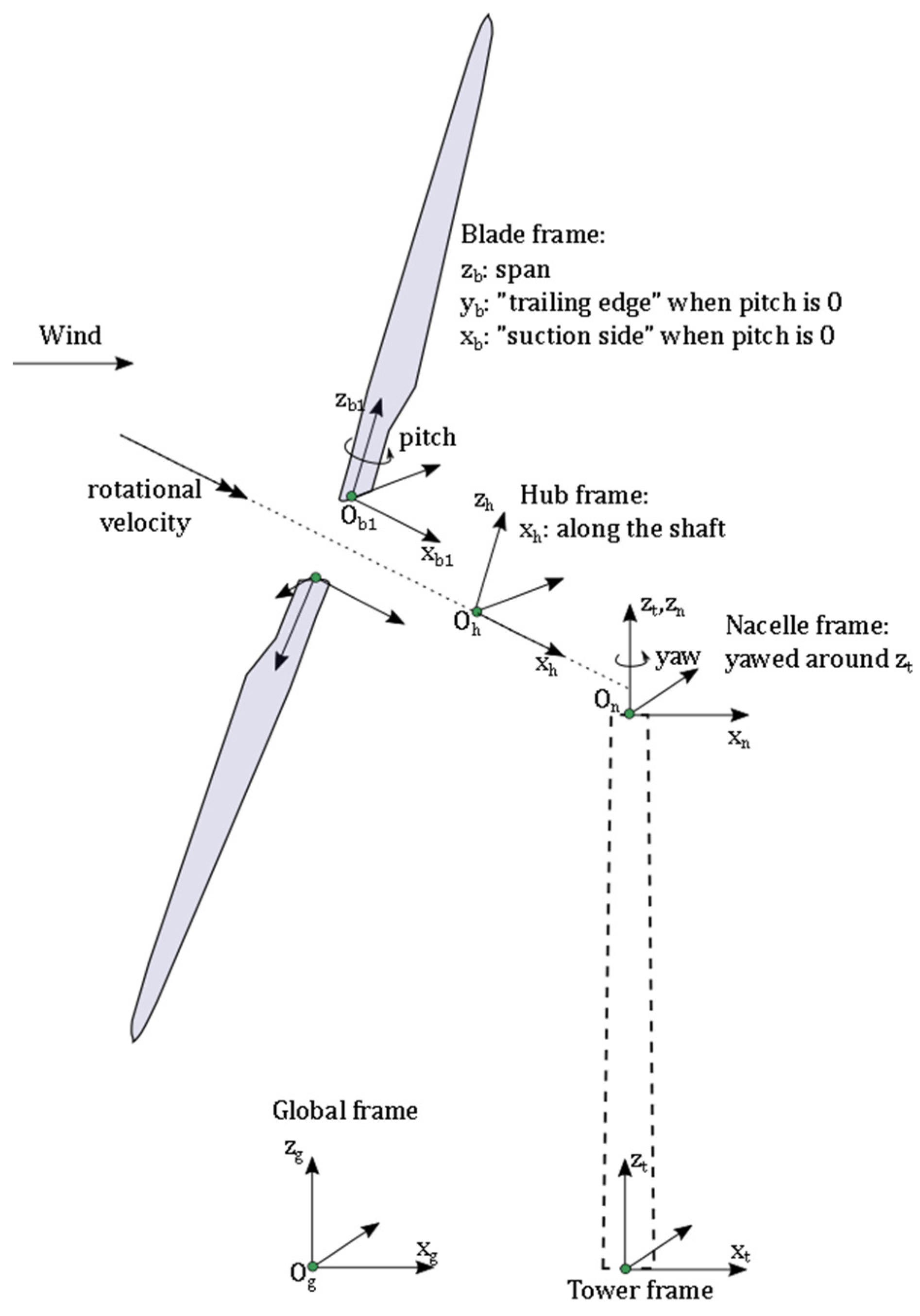
2.2.3. Model–Data Correlation
3. Results
3.1. Numerical Sensitivity Analysis of Modal Parameters
3.1.1. Considered Environmental/Operational Conditions
3.1.2. Sensitivity of Modal Parameters to Considered Conditions in OpenFAST
3.1.3. Sensitivity of Modal Parameters with Respect to Individual Operational Parameters
Effect of Wind Speed
Effect of Pitch Angle of Blades
Effect of Rotor Speed
Effect of Nacelle Yaw Angle
Effect of Mean Sea Level
Effect of Soil Stiffness
3.1.4. Analytical Sensitivity
Aerodynamic Damping—Analytical Expressions
Rotational Effects on Stiffness
3.2. Sensitivity Analysis Using Experimental Data
- : prediction of Y based on Xi = xi for any i = 1, …, 6
4. Discussion
5. Summary and Conclusions
Author Contributions
Funding
Institutional Review Board Statement
Informed Consent Statement
Data Availability Statement
Acknowledgments
Conflicts of Interest
References
- House, T.W. Fact Sheet: Biden Administration Jumpstarts Offshore Wind Energy Projects to Create Jobs; The White House: Washington, DC, USA, 2021. [Google Scholar]
- GE-Renewable-Energy. Haliade-X 14-MW Offshore Wind Turbine. Available online: https://www.ge.com/renewableenergy/wind-energy/offshore-wind/haliade-x-offshore-turbine (accessed on 1 February 2020).
- Carswell, W.; Johansson, J.; Løvholt, F.; Arwade, S.R.; Madshus, C.; DeGroot, D.J.; Myers, A.T. Foundation damping and the dynamics of offshore wind turbine monopiles. Renew. Energy 2015, 80, 724–736. [Google Scholar] [CrossRef]
- Steidel, R.F. An Introduction to Mechanical Vibrations, 1st ed.; John Wiley & Sons: Hoboken, NJ, USA, 1971; p. 464. [Google Scholar]
- Koukoura, C.; Natarajan, A.; Vesth, A. Identification of support structure damping of a full scale offshore wind turbine in normal operation. Renew. Energy 2015, 81, 882–895. [Google Scholar] [CrossRef]
- Li, N.; Shi, W.; Han, X.; Li, X.; Verma, A.S.; Liu, C. Dynamic analysis of an integrated offshore structure comprising a jacket-supported offshore wind turbine and aquaculture steel cage. Ocean Eng. 2023, 274, 114059. [Google Scholar] [CrossRef]
- Shittu, A.A.; Mehmanparast, A.; Amirafshari, P.; Hart, P.; Kolios, A. Sensitivity analysis of design parameters for reliability assessment of offshore wind turbine jacket support structures. Int. J. Nav. Archit. Ocean Eng. 2022, 14, 100441. [Google Scholar] [CrossRef]
- Yun, H.B.; Eslami, E.; Zhou, L. Noncontact stress measurement from bare UHPC surface using R aman piezospectroscopy. J. Raman Spectrosc. 2018, 49, 1540–1551. [Google Scholar] [CrossRef]
- Eslami, E.; Zhou, L.; Yun, H.-B. Noncontact Absolute Stress Measurement for UHPC Using Raman Piezospectroscopy. In Proceedings of the Transportation Research Board 98th Annual Meeting, Washington, DC, USA, 13–17 January 2019; p. 12. [Google Scholar]
- Khedmatgozar Dolati, S.S.; Caluk, N.; Mehrabi, A.; Khedmatgozar Dolati, S.S. Non-Destructive Testing Applications for Steel Bridges. Appl. Sci. 2021, 11, 9757. [Google Scholar] [CrossRef]
- Poozesh, P.; Baqersad, J.; Niezrecki, C.; Avitabile, P.; Harvey, E.; Yarala, R. Large-area photogrammetry based testing of wind turbine blades. Mech. Syst. Signal Process. 2017, 86, 98–115. [Google Scholar] [CrossRef]
- Khadka, A.; Fick, B.; Afshar, A.; Tavakoli, M.; Baqersad, J. Non-contact vibration monitoring of rotating wind turbines using a semi-autonomous UAV. Mech. Syst. Signal Process. 2020, 138, 106446. [Google Scholar] [CrossRef]
- Vahedi, M.; Khoshnoudian, F.; Hsu, T.Y.; Partovi Mehr, N. Transfer function-based Bayesian damage detection under seismic excitation. Struct. Des. Tall Spec. Build. 2019, 28, e1619. [Google Scholar] [CrossRef]
- Veritas, N. Guidelines for Design of Wind Turbines; Det Norske Veritas: Wind Energy Department, Risø National Laboratory: London, UK, 2002. [Google Scholar]
- Bhattacharya, S. Design of Foundations for Offshore Wind Turbines; John Wiley & Sons: Hoboken, NJ, USA, 2019; p. 371. [Google Scholar]
- Ziegler, L.; Muskulus, M. Fatigue Reassessment for Lifetime Extension of Offshore Wind Monopile Substructures. In Journal of Physics: Conference Series; IOP Publishing: Bristol, UK, 2016; p. 092010. [Google Scholar]
- Bouty, C.; Schafhirt, S.; Ziegler, L.; Muskulus, M. Lifetime extension for large offshore wind farms: Is it enough to reassess fatigue for selected design positions? Energy Procedia 2017, 137, 523–530. [Google Scholar] [CrossRef]
- Bouzid, D.A.; Bhattacharya, S.; Otsmane, L. Assessment of natural frequency of installed offshore wind turbines using nonlinear finite element model considering soil-monopile interaction. J. Rock Mech. Geotech. Eng. 2018, 10, 333–346. [Google Scholar] [CrossRef]
- Liu, X.; Lu, C.; Li, G.; Godbole, A.; Chen, Y. Effects of aerodynamic damping on the tower load of offshore horizontal axis wind turbines. Appl. Energy 2017, 204, 1101–1114. [Google Scholar] [CrossRef]
- Yeter, B.; Garbatov, Y.; Guedes Soares, C. Fatigue damage assessment of fixed offshore wind turbine tripod support structures. Eng. Struct. 2015, 101, 518–528. [Google Scholar] [CrossRef]
- Liu, K.; Yan, R.-J.; Guedes Soares, C. Damage identification in offshore jacket structures based on modal flexibility. Ocean Eng. 2018, 170, 171–185. [Google Scholar] [CrossRef]
- Renqiang, X.; Xiuli, D.; Piguang, W.; Chengshun, X.; Endi, Z.; Suyu, W. Dynamic analysis of 10 MW monopile supported offshore wind turbine based on fully coupled model. Ocean Eng. 2021, 234, 109346. [Google Scholar] [CrossRef]
- Joey, V.; Claus, K.; John Dalsgaard, S.; Gianluca, Z. Fatigue reliability of large monopiles for offshore wind turbines. Int. J. Fatigue 2020, 134, 105487. [Google Scholar] [CrossRef]
- Ding, L.; Shun-Peng, Z.; José, A.F.O.C.; Abílio, M.P.; Milan, V.; Filippo, B. Fatigue reliability of wind turbines: Historical perspectives, recent developments and future prospects. Renew. Energy 2022, 200, 724–742. [Google Scholar] [CrossRef]
- Augustyn, D.; Ulriksen, M.D.; Sørensen, J.D. Reliability Updating of Offshore Wind Substructures by Use of Digital Twin Information. Energies 2021, 14, 5859. [Google Scholar] [CrossRef]
- Dong, X.; Lian, J.; Wang, H.; Yu, T.; Zhao, Y. Structural vibration monitoring and operational modal analysis of offshore wind turbine structure. Ocean Eng. 2018, 150, 280–297. [Google Scholar] [CrossRef]
- Norén-Cosgriff, K.; Kaynia, A.M. Estimation of natural frequencies and damping using dynamic field data from an offshore wind turbine. Mar. Struct. 2021, 76, 102915. [Google Scholar] [CrossRef]
- Hu, W.-H.; Thöns, S.; Rohrmann, R.G.; Said, S.; Rücker, W. Vibration-based structural health monitoring of a wind turbine system Part II: Environmental/operational effects on dynamic properties. Eng. Struct. 2015, 89, 273–290. [Google Scholar] [CrossRef]
- Petersen, B.; Pollack, M.; Connell, B.; Greeley, D.; Davis, D.; Slavik, C.; Goldman, B.; Medley, L. Evaluate the Effect of Turbine Period of Vibration Requirements on Structural Design Parameters: Technical Report of Findings; Applied Physical Sciences Corp.: Groton, CT, USA, 2010; p. 130. [Google Scholar]
- Jonkman, B.; Mudafort, R.M.; Platt, A.; Branlard, E.; Sprague, M.; Jonkman, J.; Hayman, G.; Vijayakumar, G.; Buhl, M.; Ross, H.; et al. OpenFAST/openfast: OpenFAST v3.2.0, v3.2.0; Zenodo: 2022. Available online: https://zenodo.org/record/6827846 (accessed on 16 May 2023).
- Jonkman, J. FAST modularization framework for wind turbine simulation: Full-system linearization. J. Phys. Conf. Ser. 2016, 753, 082010. [Google Scholar] [CrossRef]
- Meng, H.; Jin, D.; Li, L.; Liu, Y. Analytical and numerical study on centrifugal stiffening effect for large rotating wind turbine blade based on NREL 5MW and WindPACT 1.5 MW models. Renew. Energy 2021, 183, 321–329. [Google Scholar] [CrossRef]
- Prowell, I.; Elgamal, A.-W.M.; Jonkman, J.M. FAST Simulation of Wind Turbine Seismic Response. In Proceedings of the Asian-Pacific Network of Centers for Earthquake Engineering Research (ANCER) Workshop, Urbana-Champaign, IL, USA, 13–14 August 2009; p. 15. [Google Scholar]
- Chen, C.; Duffour, P.; Fromme, P. Modelling wind turbine tower-rotor interaction through an aerodynamic damping matrix. J. Sound Vib. 2020, 489, 115667. [Google Scholar] [CrossRef]
- OpenFAST. OpenFAST Documentation. Available online: http://openfast.readthedocs.io/ (accessed on 16 May 2023).
- Mazzoni, S.; McKenna, F.; Scott, M.H.; Fenves, G.L. OpenSees command language manual. Pac. Earthq. Eng. Res. (PEER) Cent. 2006, 264, 137–158. [Google Scholar]
- Okumus, P.; Basereh, S. Simplified Analytical Models for Evaluating Retrofitted Reinforced Concrete Shear Walls. In Proceedings of the 17th World Conference on Earthquake Engineering, 17WCEE, Sendai, Japan, 13–18 September 2020. [Google Scholar]
- Taslimi, A.; Tehranizadeh, M. The effect of vertical near-field ground motions on the collapse risk of high-rise reinforced concrete frame-core wall structures. Adv. Struct. Eng. 2022, 25, 410–425. [Google Scholar] [CrossRef]
- Khedmatgozar Dolati, S.S.; Mehrabi, A.; Dolati, S.S.K. Application of VD-LRBP System for Bridges in Seismic Zones. In Proceedings of the Active and Passive Smart Structures and Integrated Systems XVI, Long Beach, CA, USA, 6 March–11 April 2022; pp. 44–52. [Google Scholar]
- Soraghi, A.; Huang, Q. Simple rebar anchorage slip macromodel considering corrosion. Eng. Struct. 2022, 262, 114357. [Google Scholar] [CrossRef]
- Moeini, M.; Ghyabi, M.; Dolatshahi, K.M. Seismic Soil-Pile Interaction Considering Nonlinear Soil Column Behavior in Saturated and Dry Soil Conditions. Int. J. Geotech. Geol. Eng. 2017, 11, 188–194. [Google Scholar] [CrossRef]
- Jonkman, J.; Butterfield, S.; Musial, W.; Scott, G. Definition of a 5-MW Reference Wind Turbine for Offshore System Development; National Renewable Energy Lab.(NREL): Golden, CO, USA, 2009; p. 75. [Google Scholar]
- Hines, E.M.; Baxter, C.D.; Ciochetto, D.; Song, M.; Sparrevik, P.; Meland, H.J.; Strout, J.M.; Bradshaw, A.; Hu, S.-L.; Basurto, J.R. Structural instrumentation and monitoring of the Block Island Offshore Wind Farm. Renew. Energy 2023, 202, 1032–1045. [Google Scholar] [CrossRef]
- Van Overschee, P.; De Moor, B. Subspace Identification for Linear Systems: Theory—Implementation—Applications; Springer Science & Business Media: New York, NY, USA, 2012. [Google Scholar]
- Moser, P. Continuous monitoring of the Dowling Hall Footbridge. Ph.D. Thesis, Tufts University, Medford, MA, USA, 2010. [Google Scholar]
- Peeters, B. System Identification and damage Detection in Civil Engeneering. Ph.D. Thesis, Katholike Universite Leuven, Belgium, 2000. [Google Scholar]
- Song, M.; Partovi Mehr, N.; Moaveni, B.; Hines, E.M.; Ebrahimian, H.; Bajric, A. One Year Monitoring of an Offshore Wind Turbine: Variability of Modal Parameters to Ambient and Operational Conditions. Eng. Struct. 2023. [Google Scholar]
- Song, M.; Moaveni, B.; Ebrahimian, H.; Hines, E.; Bajric, A. Joint parameter-input estimation for digital twinning of the Block Island wind turbine using output-only measurements. Mech. Syst. Signal Process. 2023, 198, 110425. [Google Scholar] [CrossRef]
- Jonkman, J. The new modularization framework for the FAST wind turbine CAE tool (NREL/CP-5000-57228). In Proceedings of the 51st AIAA Aerospace Sciences Meeting, including the New Horizons Forum and Aerospace Exposition, Dallas, TX, USA, 7–10 January 2013. [Google Scholar]
- Branlard, E. Wind Turbine Aerodynamics and Vorticity-Based Methods: Fundamentals and Recent Applications; Springer: Cham, Switzerland, 2017; Volume 7. [Google Scholar]
- Hansen, M.O.L. Aerodynamics of Wind Turbines, 3rd ed.; Routledge: London, UK; New York, NY, USA, 2015; p. 192. [Google Scholar]
- Branlard, E.; Shields, M.; Anderson, B.; Damiani, R.; Wendt, F.; Jonkman, J.; Musial, W.; Foley, B. Superelement reduction of substructures for sequential load calculations in OpenFAST. In Journal of Physics: Conference Series; IOP Publishing: Bristol, UK, 2020; p. 12033. [Google Scholar]
- Moriarty, P.J.; Hansen, A.C. AeroDyn Theory Manual (NREL/EL-500-36881); National Renewable Energy Lab. (NREL): Golden, CO, USA, 2005; p. 47. [Google Scholar]
- Jonkman, J.M.; Robertson, A.N.; Hayman, G.J. HydroDyn User’s Guide and Theory Manual; National Renewable Energy Laboratory: Golden, CO, USA, 2021. [Google Scholar]
- Johnson, N.; Jonkman, J.; Wright, A.; Hayman, G.; Robertson, A. Verification of Floating Offshore Wind Linearization Functionality in OpenFAST. In Journal of Physics: Conference Series; IOP Publishing: Bristol, UK, 2019; p. 012022. [Google Scholar]
- Coleman, R.P.; Feingold, A.M. Theory of Self-Excited Mechanical Oscillations of Helicopter Rotors with Hinged Blades; National Advisory Committee for Aeronautics (NACA): Washington, DC, USA, 1957. [Google Scholar]
- Branlard, E.; Brownstein, I.; Strom, B.; Jonkman, J.; Dana, S.; Baring-Gould, E.I. A multi-purpose lifting-line flow solver for arbitrary wind energy concepts. Wind Energy Sci. 2021, 7, 455–467. [Google Scholar] [CrossRef]
- Yeter, B.; Garbatov, Y.; Guedes Soares, C. Uncertainty analysis of soil-pile interactions of monopile offshore wind turbine support structures. Appl. Ocean Res. 2019, 82, 74–88. [Google Scholar] [CrossRef]
- Shirzadeh, R.; Devriendt, C.; Bidakhvidi, M.A.; Guillaume, P. Experimental and computational damping estimation of an offshore wind turbine on a monopile foundation. J. Wind Eng. Ind. Aerodyn. 2013, 120, 96–106. [Google Scholar] [CrossRef]
- Valamanesh, V.; Myers, A.T. Aerodynamic damping and seismic response of horizontal axis wind turbine towers. J. Struct. Eng. 2014, 140, 04014090. [Google Scholar] [CrossRef]
- Salzmann, D.J.C.; Van der Tempel, J. Aerodynamic damping in the design of support structures for offshore wind turbines. In Proceedings of the Copenhagen Offshore Wind Conference, Copenhagen, Denmark, 26–28 October 2005; pp. 26–28. [Google Scholar]
- Ozbek, M.; Rixen, D.J. Operational modal analysis of a 2.5 MW wind turbine using optical measurement techniques and strain gauges. Wind Energy 2013, 16, 367–381. [Google Scholar] [CrossRef]
- Van Der Tempel, J. Design of Support Structures for Offshore Wind Turbines. Ph.D. Thesis, TU Delft, Delft, The Netherlands, 2006. [Google Scholar]
- Manwell, J.F.; McGowan, J.G.; Rogers, A.L. Wind Energy Explained: Theory, Design and Application, 3rd ed.; John Wiley & Sons: Hoboken, NJ, USA, 2010. [Google Scholar]
- Hansen, M.H. Improved modal dynamics of wind turbines to avoid stall-induced vibrations. Wind Energy: Int. J. Prog. Appl. Wind Power Convers. Technol. 2003, 6, 179–195. [Google Scholar] [CrossRef]
- Malcolm, D.J. Modal response of 3-bladed wind turbines. ASME J. Sol. Energy Eng. 2002, 124, 372–377. [Google Scholar] [CrossRef]
- Bahramiasl, S.; Abbaspour, M.; Karimirad, M. Experimental study on gyroscopic effect of rotating rotor and wind heading angle on floating wind turbine responses. Int. J. Environ. Sci. Technol. 2018, 15, 2531–2544. [Google Scholar] [CrossRef]
- Høeg, C.E.; Zhang, Z. The influence of gyroscopic effects on dynamic responses of floating offshore wind turbines in idling and operational conditions. Ocean Eng. 2021, 227, 108712. [Google Scholar] [CrossRef]
- Staino, A.; Basu, B. Dynamics and control of vibrations in wind turbines with variable rotor speed. Eng. Struct. 2013, 56, 58–67. [Google Scholar] [CrossRef]
- Peeters, B.; De Roeck, G. Reference-based stochastic subspace identification for output-only modal analysis. Mech. Syst. Signal Process. 1999, 13, 855–878. [Google Scholar] [CrossRef]
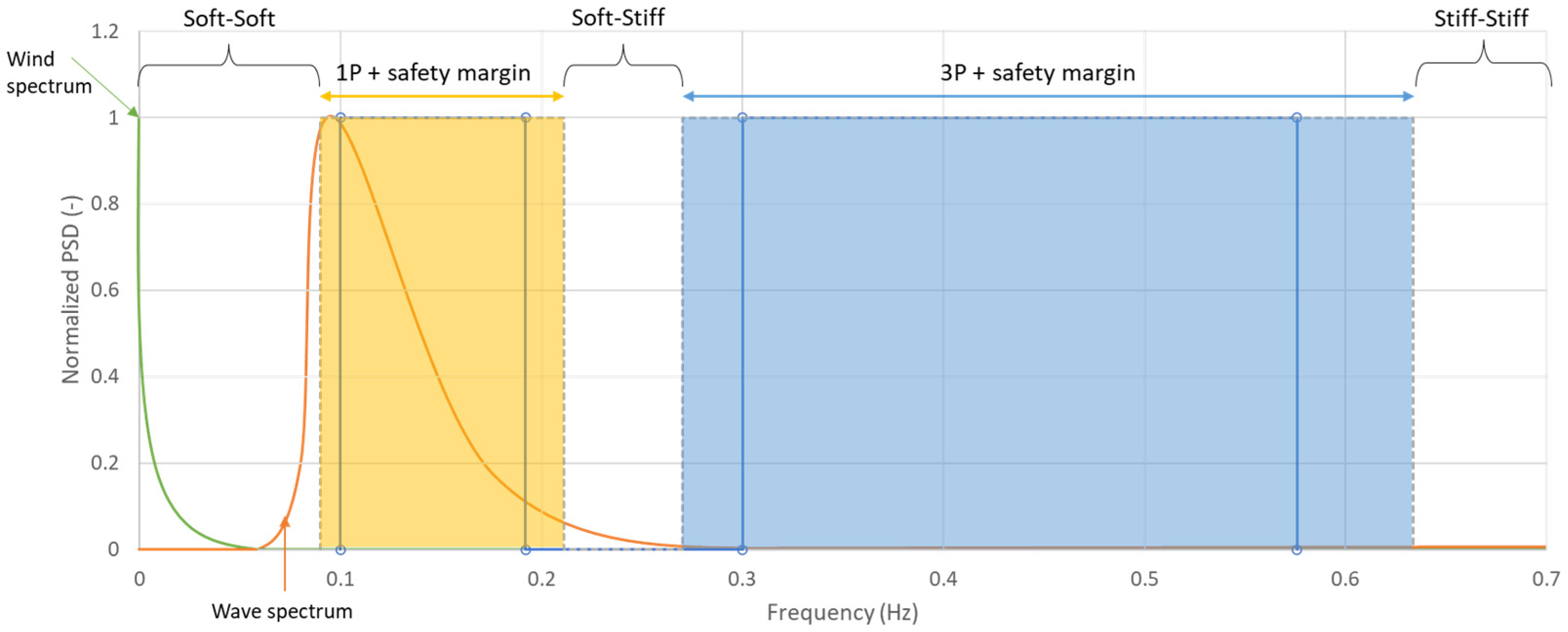
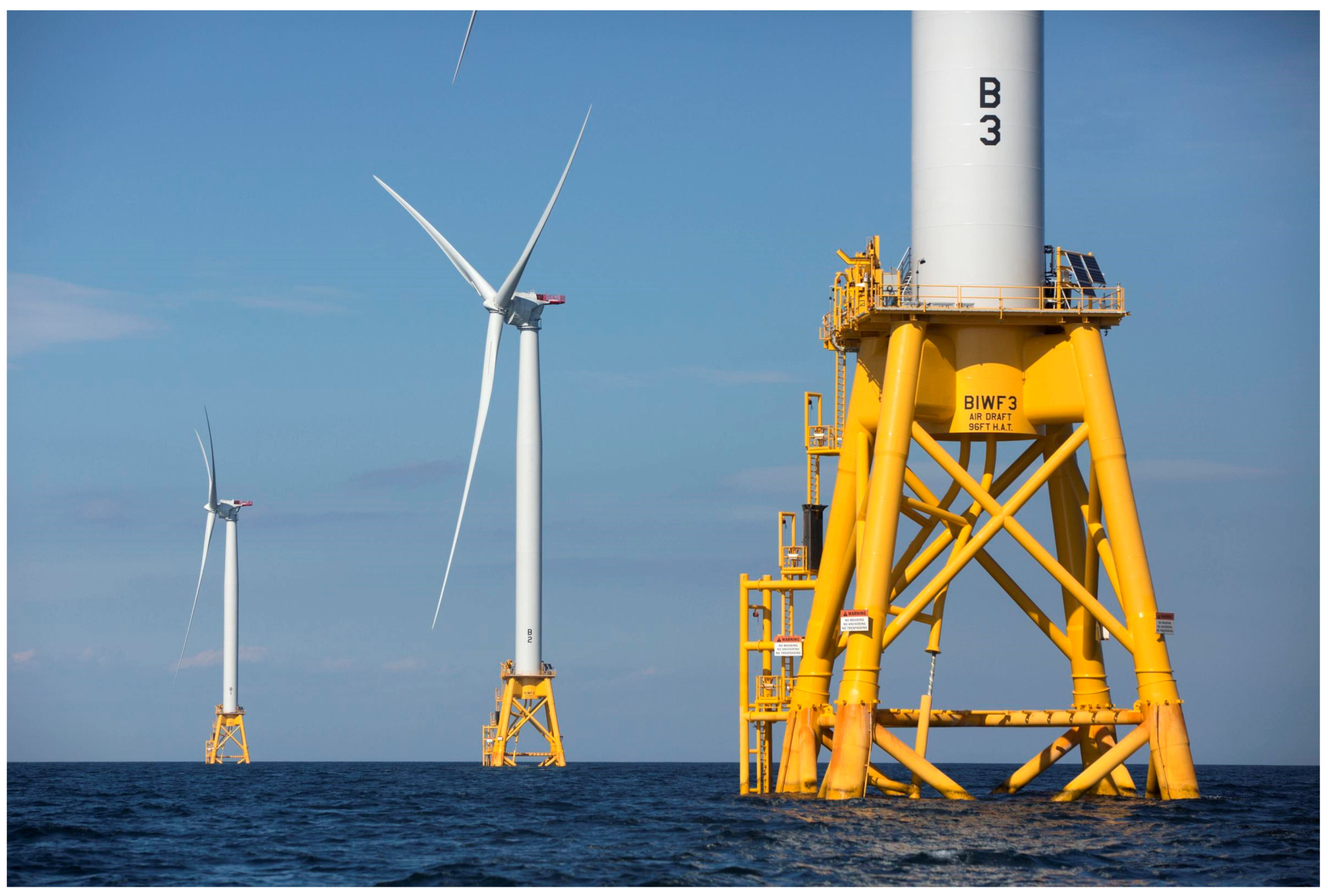
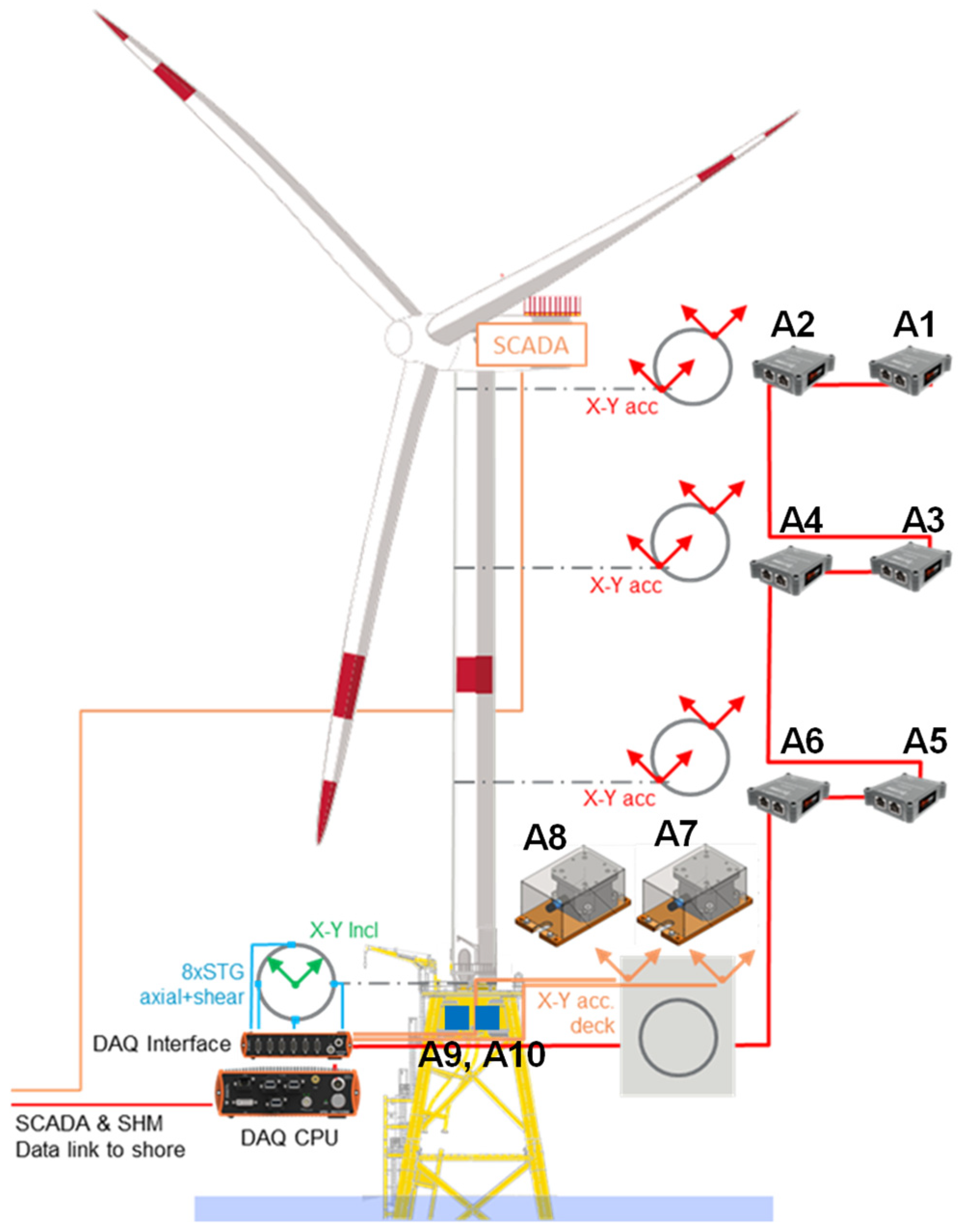
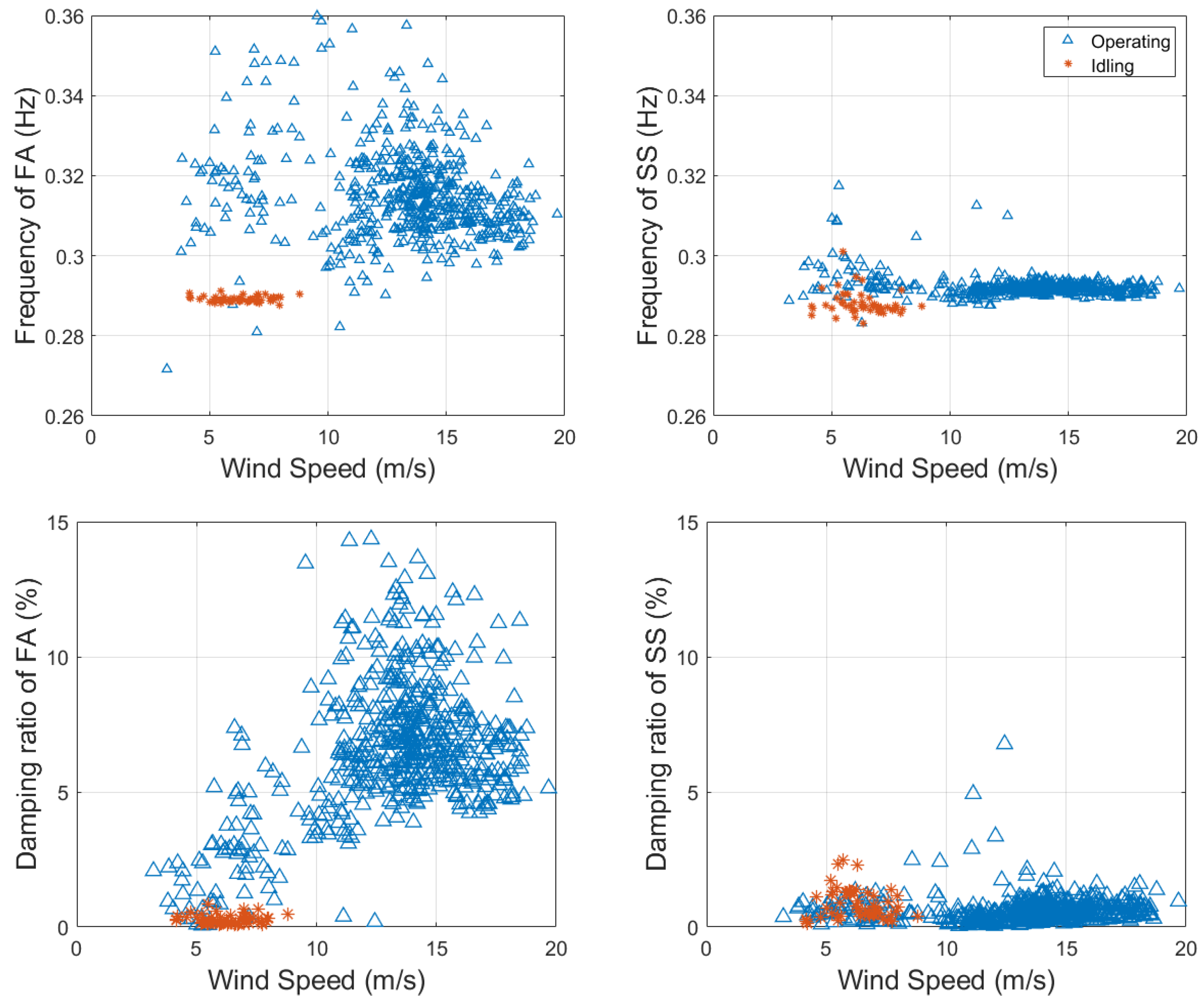
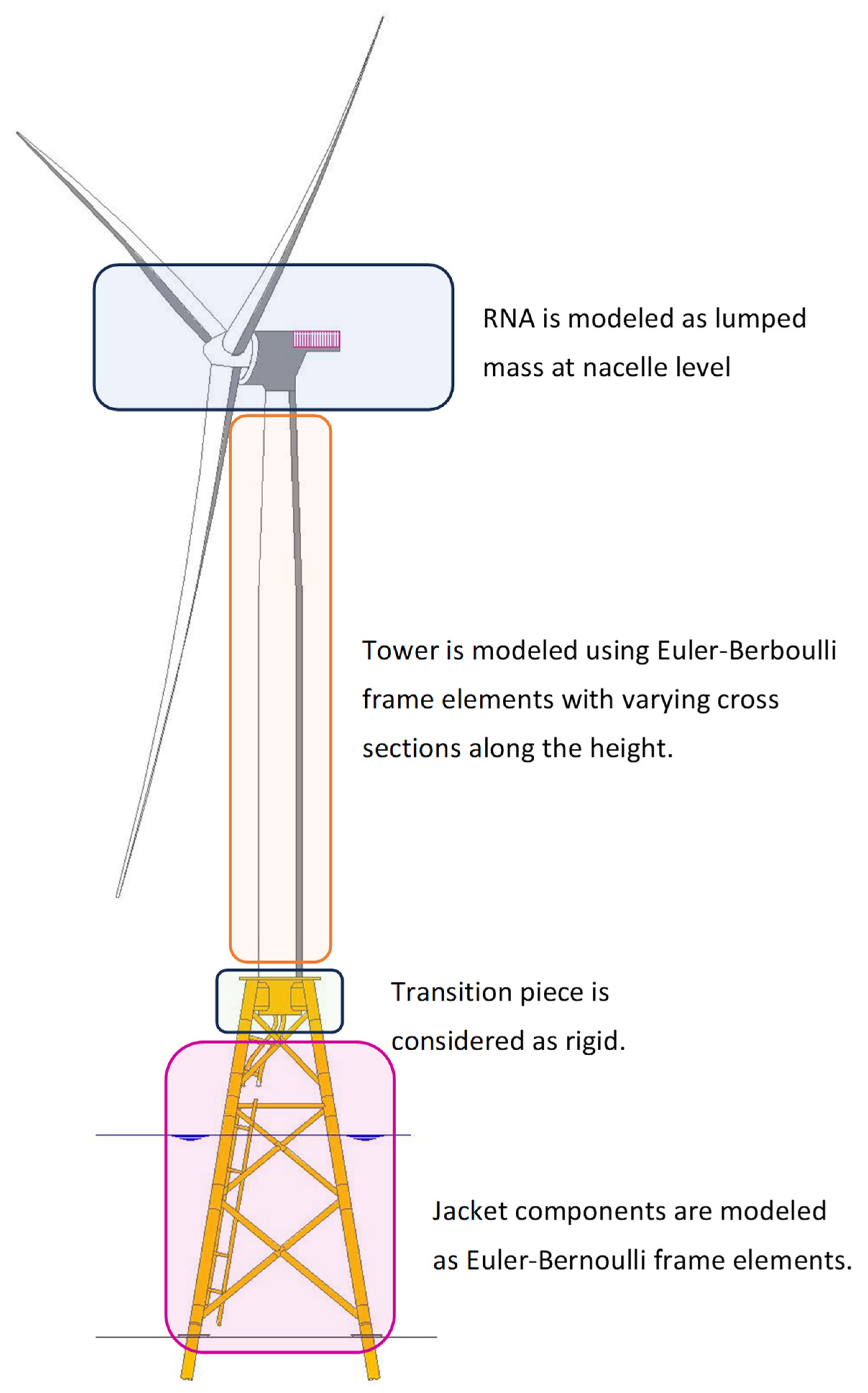
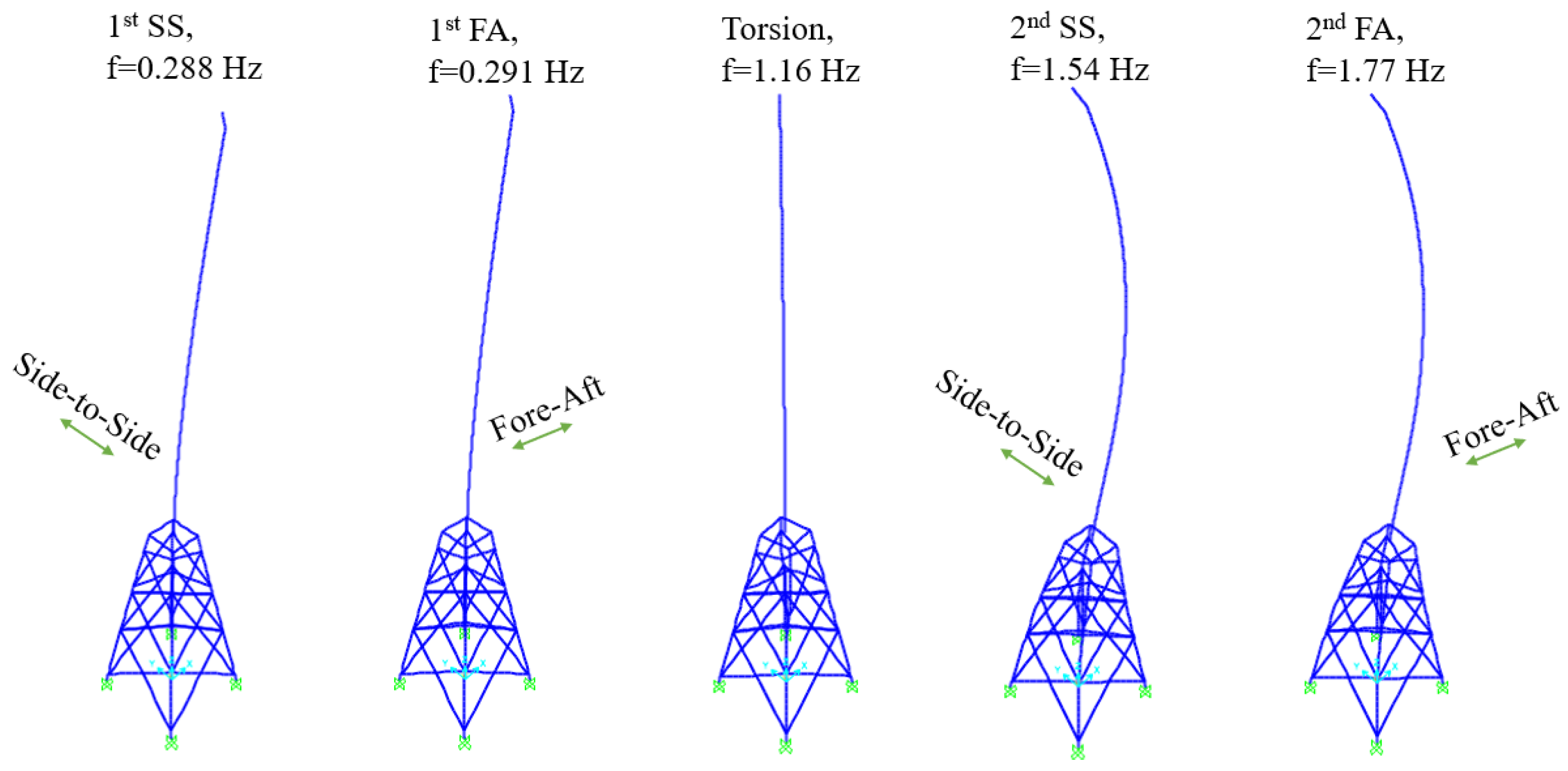

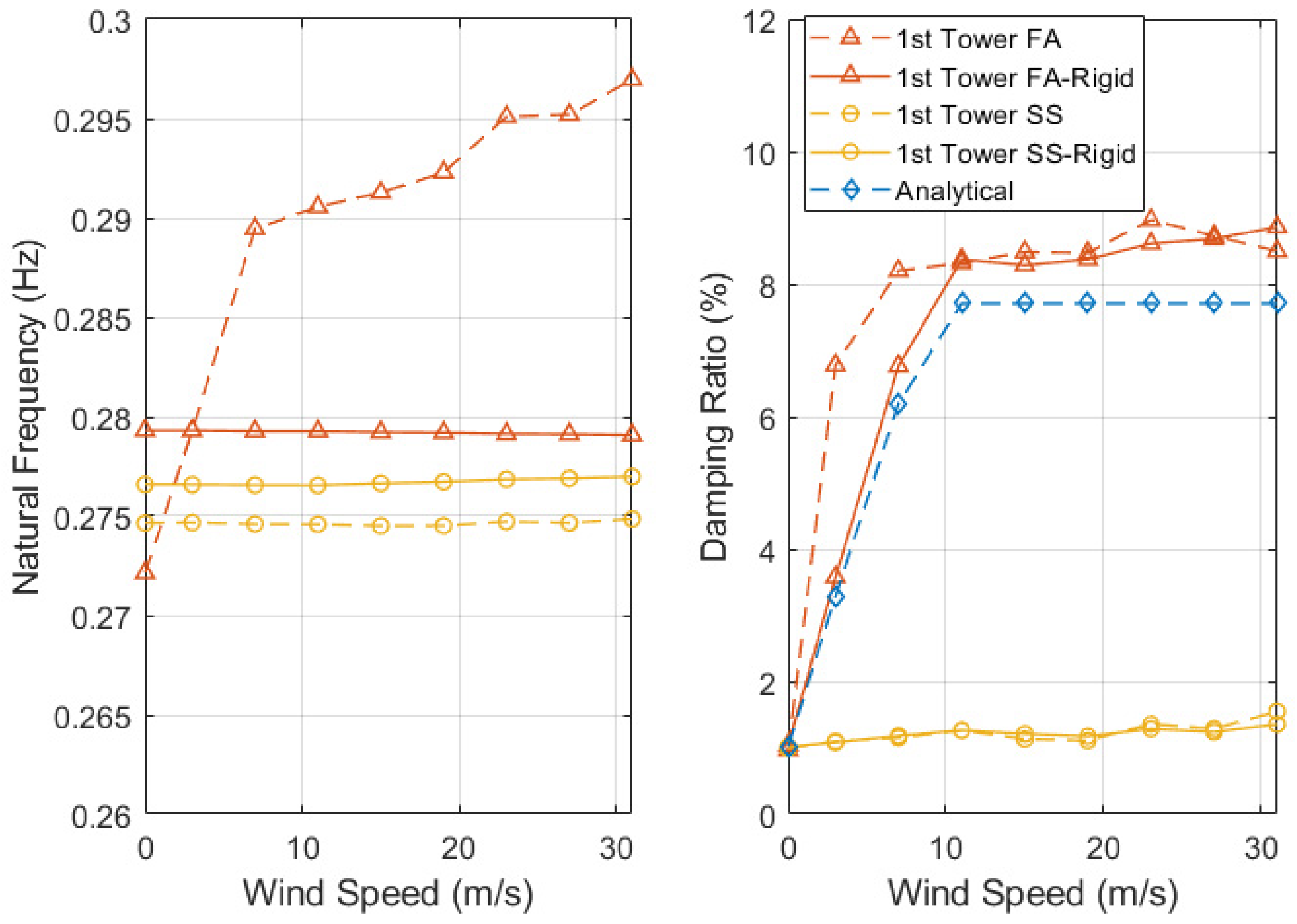

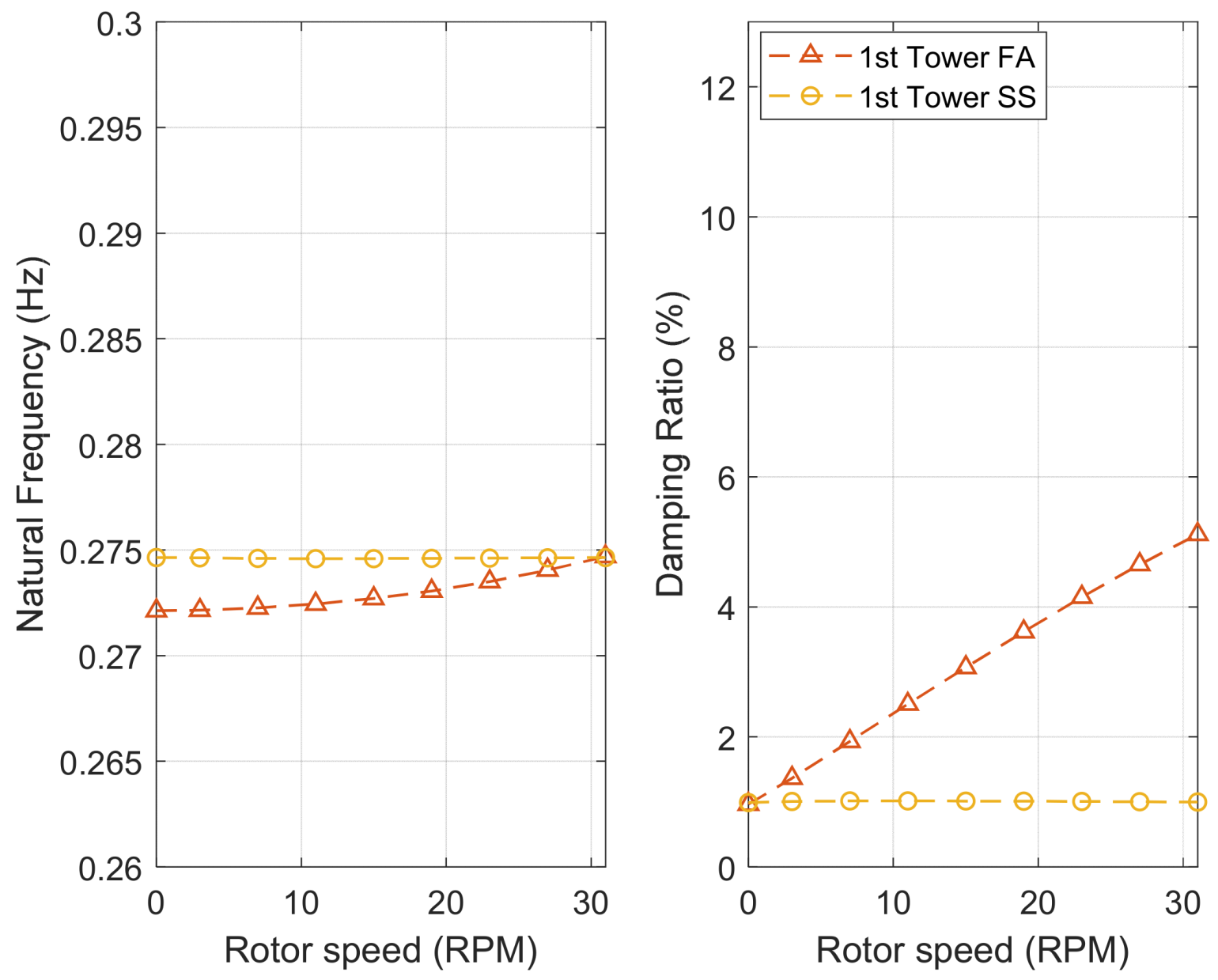
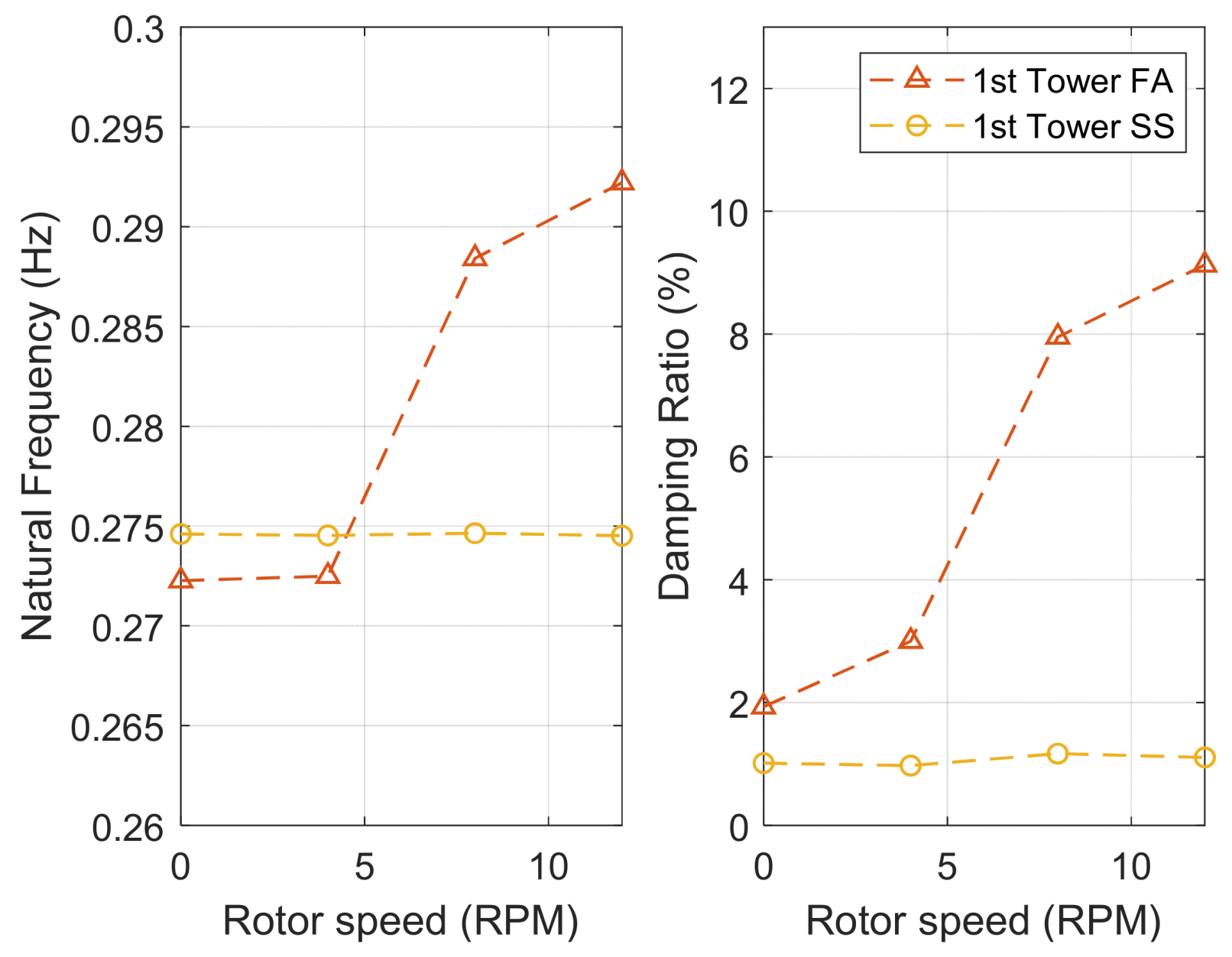
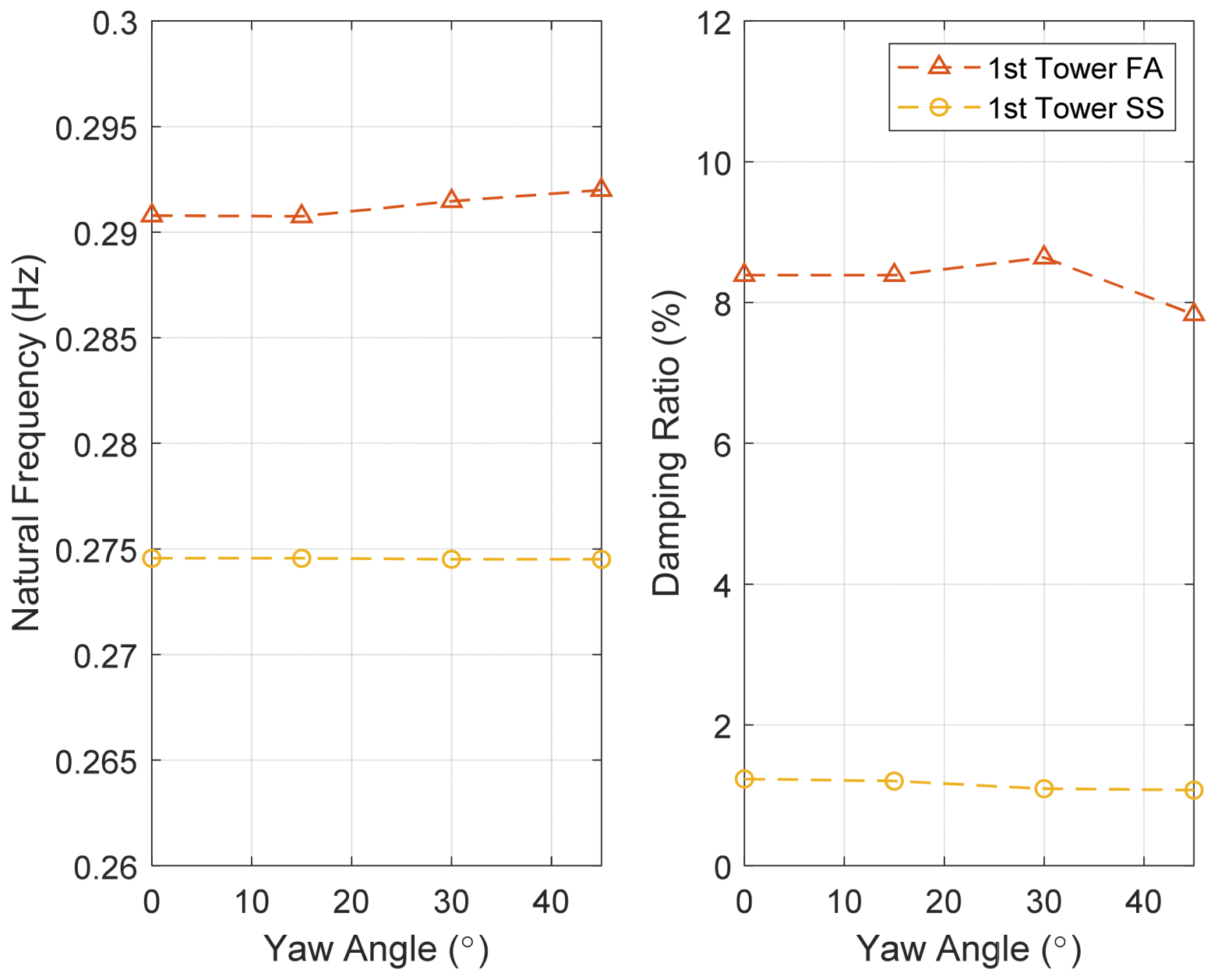
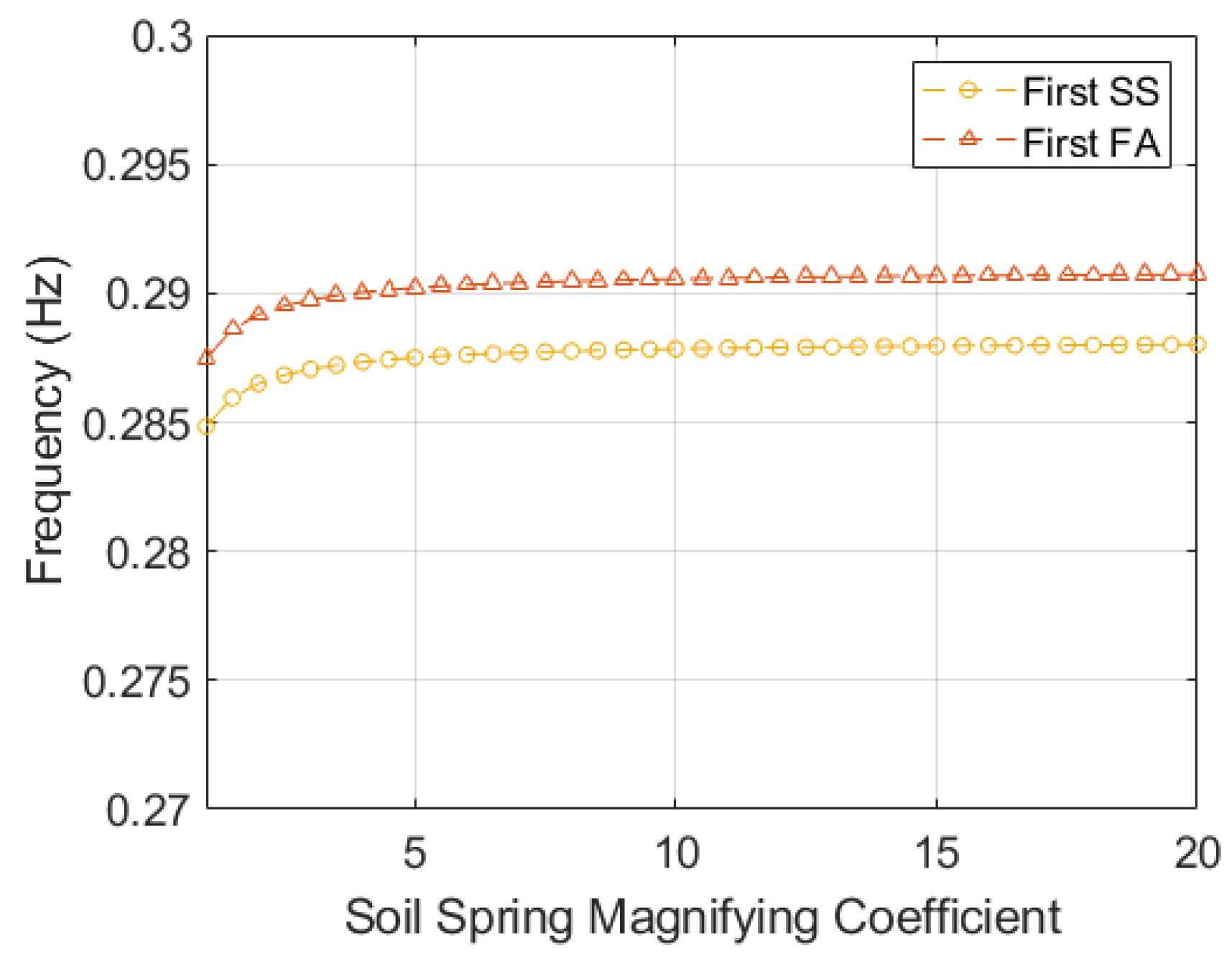
| Mode | OpenFAST Freq. [Hz] Flexible | OpenFAST Freq. [Hz] Rigid | OpenSees Freq. [Hz] | Mean (std) Identified Freq. [Hz] | Mean (std) MAC of OpenFAST vs. Identified | Mean (std) MAC of Opensees vs. Identified |
|---|---|---|---|---|---|---|
| First SS | 0.275 | 0.277 | 0.288 | 0.292 (0.001) 1 | 0.97 (0.04) 1 | 0.97 (0.04) 1 |
| First FA | 0.272 | 0.279 | 0.291 | 0.313 (0.007) | 0.92 (0.06) | 0.92 (0.06) |
| Second SS | 1.66 | 1.60 | 1.54 | 1.98 (0.016) | 0.95 (0.03) | 0.97 (0.03) |
| Second FA | 2.41 | 1.87 | 1.77 | 2.24 (0.076) | 0.94 (0.07) | 0.93 (0.07) |
| Region | Wind Speed (m/s) | Rotor Speed (rpm) | Blade Pitch (°) |
|---|---|---|---|
| Region 1 | 0.0 | 0.0 | 0 |
| Region 2 | 3.0 | 3.9 | 0 |
| 7.0 | 8.9 | 0 | |
| 11.0 | 11.5 | 0 | |
| Region 3 * | 15 | 11.5 | 9 |
| 19 | 11.5 | 14 | |
| 23 | 11.5 | 19 | |
| 27 * | 11.5 * | 24 * | |
| 31 * | 11.5 * | 29 * |
| Wind Speed (m/s) | Rotor Aero CT (-) | TSR (-) |
|---|---|---|
| 11 | 0.61 | 8.19 |
| 15 | 0.45 | 5.98 |
| 19 | 0.33 | 4.70 |
| 23 | 0.20 | 3.92 |
| 27 | 0.18 | 3.33 |
| 31 | 0.16 | 2.82 |
| Model | FA Frequency | FA Damping |
|---|---|---|
| 1 | 0.38 | 0.59 |
| 2 | 0.46 | 0.63 |
| 3 | 0.48 | 0.64 |
| Regression Coefficient | Related Variable Name | FA Frequency | FA Damping |
|---|---|---|---|
| Intercept () | Constant | 0.30 | 1.80 |
| Wind speed | −0.01 | −1.48 | |
| Rotor speed | 0.06 | 3.90 | |
| Power | −0.03 | 3.21 | |
| Yaw | −0.01 | −0.81 | |
| Misalignment | −0.01 | −0.95 | |
| Pitch | −0.01 | −1.57 |
Disclaimer/Publisher’s Note: The statements, opinions and data contained in all publications are solely those of the individual author(s) and contributor(s) and not of MDPI and/or the editor(s). MDPI and/or the editor(s) disclaim responsibility for any injury to people or property resulting from any ideas, methods, instructions or products referred to in the content. |
© 2023 by the authors. Licensee MDPI, Basel, Switzerland. This article is an open access article distributed under the terms and conditions of the Creative Commons Attribution (CC BY) license (https://creativecommons.org/licenses/by/4.0/).
Share and Cite
Partovi-Mehr, N.; Branlard, E.; Song, M.; Moaveni, B.; Hines, E.M.; Robertson, A. Sensitivity Analysis of Modal Parameters of a Jacket Offshore Wind Turbine to Operational Conditions. J. Mar. Sci. Eng. 2023, 11, 1524. https://doi.org/10.3390/jmse11081524
Partovi-Mehr N, Branlard E, Song M, Moaveni B, Hines EM, Robertson A. Sensitivity Analysis of Modal Parameters of a Jacket Offshore Wind Turbine to Operational Conditions. Journal of Marine Science and Engineering. 2023; 11(8):1524. https://doi.org/10.3390/jmse11081524
Chicago/Turabian StylePartovi-Mehr, Nasim, Emmanuel Branlard, Mingming Song, Babak Moaveni, Eric M. Hines, and Amy Robertson. 2023. "Sensitivity Analysis of Modal Parameters of a Jacket Offshore Wind Turbine to Operational Conditions" Journal of Marine Science and Engineering 11, no. 8: 1524. https://doi.org/10.3390/jmse11081524
APA StylePartovi-Mehr, N., Branlard, E., Song, M., Moaveni, B., Hines, E. M., & Robertson, A. (2023). Sensitivity Analysis of Modal Parameters of a Jacket Offshore Wind Turbine to Operational Conditions. Journal of Marine Science and Engineering, 11(8), 1524. https://doi.org/10.3390/jmse11081524









